|
8 -
ENCOUNTERS IN THE GIGUNU
More than 2,500 years after the epic search for Immortality by
Gilgamesh, another legendary king - Alexander of Macedonia - emulated
the Sumerian king and Egyptian Pharaohs in the very same arena. In
his case, too, the claim to Immortality was based on being partly
divine.
The evidence suggests that Alexander, through his teacher
Aristotle, was aware of the earlier searches; but what he probably
did not know was that the root of his specific claim to divine
parentage lay in Uruk’s GIPAR ("Nighttime House") and its inner
sanctum, the GIGUNU.
Soon after Alexander was crowned king of Macedonia in lieu of the
assassinated Philip II, he went to Delphi in Greece to consult its
famed Oracle. Only twenty years old at the time, he was shocked to
hear the first of several prophecies predicting for him fame, but a
very short life.
The prophecies served to increase his belief in
rumors that had been circulating in the Macedonian court, according
to which Philip II was not really his father; but that he was really
the son of an Egyptian Pharaoh by name of Nectanebus who had visited
the Macedonian court and secretly seduced Olympias, Alexander’s
mother. And Nectanebus - a master magician and diviner - so the
whispering went, was in fact the Egyptian God Amon, who disguised
himself as a man in order to sire the future conqueror of the world.
No sooner did Alexander reach Egypt (in 332 B.C.) than, after paying
homage to Egyptian Gods and priests, he set his course to the
oasis
of Siwah in the western desert, the seat of a renowned Oracle of
Amon. There (so the historians who
had accompanied him reported) the great God himself confirmed
Alexander’s divine parentage. Thus affirmed as truly the son of a
God, the Egyptian priests proclaimed him a Divine Pharaoh.
But
instead of waiting to the and attain immortality in the Afterlife,
Alexander set out to find the famed Waters of Life right away. His
searches took him to subterranean places filled with magic and
angels in the Sinai peninsula, then (on orders of a Winged Man) to
Babylon. In the end, as the Delphic Oracle prophesied, he died
famous but young.
In his search for immortality Alexander, leaving his troops behind,
went toward the Land of Darkness, to find there a mountain called
Mushas. At the edge of the desert he left his few trusted companions
and proceeded alone. He saw and followed "a straight path that had
no wall, and it had no high or low place in it." He walked therein
twelve days and twelve nights, at which point "he perceived the
radiance of an angel." As he drew nearer the radiance became "a
flaming fire," and Alexander realized that he was at the "mountain
from which the whole world is surrounded."
Speaking to Alexander from the flaming fire, the angel questioned
him, "Who art thou, and for what reason art thou here, O mortal?"
and wondered how Alexander had managed "to penetrate into this
darkness, which no other mortal hath been able to do." Alexander
explained that God himself had guided him and gave him strength to
arrive at this place, "which is Paradise." But the angel told him
that the Water of Life was somewhere else; "and whosoever drinketh
therefrom, if it be but a single drop, shall never die."
To find the "Well of the Water of Life" Alexander needed a savant
who knew such secrets, and after much searching such a man was
found. Magical and miraculous adventures took place on their way. To
be certain that the well is the right one, the two had with them a
dead dried fish. One night, reaching a subterranean fountain, and
while Alexander was sleeping, the guide tested the water and the
fish came alive.
Then he himself immersed in the waters, becoming
thereby El Khidr - "The Evergreen" - the One Who Is Forever Young of
Arab legends. In the morning Alexander rushed to the indicated
place. It was "inlaid with sapphires and emeralds and jacinths." But
there two birds with human features blocked
his way. "The land on which you stay belongs to God alone," they
announced. Realizing that he could not change his fate, Alexander
gave up the search and instead started to build cities bearing his
name, thereby to be forever remembered.
The numerous details of the Alexander search that are virtually
identical to those of Gilgamesh - the location, the name of the
mountain, the twelve periods of the subterranean journey, the
winged Birdmen, the questioning by the guards, the immersion in the
well of the Waters of Life - indicate a familiarity with the Epic of
Gilgamesh; not only with the literary work (which continued to
survive to our times), but also with the raison d’etre for the
search - the partial divinity, the divine parentage, of Gilgamesh.
Indeed, even the claims by Egyptian Pharaohs that they were fathered
by Gods or, in the very least, nourished with mother’s milk by a
Goddess, can be traced to the time and place of Gilgamesh; for it
was in Uruk that the custom and tradition began with the dynasty to
which Gilgamesh belonged.
The Kingship began in Uruk, it will be recalled, when the future
city consisted almost entirely only of the sacred precinct. There,
according to the Sumerian King Lists, "Mes-kiag-gasher, the son of
the God Utu, became high priest as well as king." Then, after reigns
by Enmerkar and Lugal-banda and an intermediate reign by the divine
Dumuzi, Gilgamesh ascended the throne; and he, as stated, was the
son of the Goddess Ninsun.
These are astounding revelations, especially in light of the episode
of the taking of human wives by the Nefilim that caused Enlil to
seek the annihilation of Mankind. It took Mankind, the Anunnaki, and
the Earth itself millennia to recover from the trauma of the
Deluge. It took millennia for the Anunnaki to gradually, and step by
careful step, grant Mankind knowledge, technology, domestication,
and, finally, full-fledged civilizations. It took the better part of
a millennium to develop, in Kish, the institution of Kingship. And
then, so unexpectedly, boom! Kingship is transferred to Uruk, and
the first dynasty is begun by a son of a God (Utu/Sha-mash) and a
human female ...
While the sexual shenanigans of other deities (some already
mentioned, more to come) have been recorded in the
ancient texts, Utu/Shamash does not appear to be one of them. His
official spouse and consort was the Goddess Aia (Fig. 51) and the
texts do not ascribe any infidelities to him. Yet here we encounter
a son of his by a human female, a son whose name, functions, and
locale are clearly stated. What was going on? Have the taboos been
removed, or just ignored by the new generation?
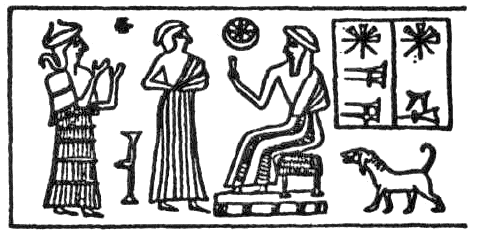
Figure 51
Even more peculiar was the case of Ninsun, the
mother of Gilgamesh
(Fig. 52). Her own genealogy and the record of her offspring are
illustrative of the mixing of generations that was taking place
among the Anunnaki - perhaps as a result of the fact that some
retained the longevities acquired on Nibiru (and counted in Sars),
others (the first generation on Earth) partly affected by Earth’s
shorter cycles, and yet others (third and fourth generations) more
Earthlike than Nibiman.
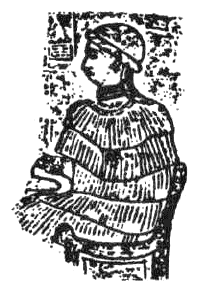
Figure 52
Anu, who besides his official spouse Antu had numerous concubines
and (at least in one instance) ventured even farther afield, had as
a result a great number of official and unofficial offspring; we
have met so far Enki, Enlil, and Nin-mah, all three half brothers
and half sister of each other (i.e. born of different mothers).
It
turns out that Anu had yet another, younger daughter, named Bau, who
became the wife of Ninurta, Enlil’s son by his half sister Ninmah.
As far as one can judge from the texts, Ninurta and Bau (Fig. 53)
led an immaculate marriage, unmarred by any infidelities.
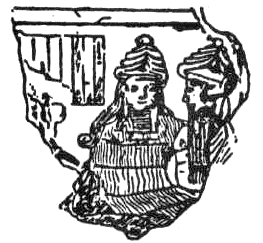
Figure 53
It was a
marriage blessed by two sons and seven daughters, of whom Ninsun
("Lady Wild Cow") was the best-known one. This genealogy made her at
one and the same time a granddaughter of Anu as well as a
granddaughter of Anu’s son Enlil. (Enlil, it ought to be mentioned
here, begot Ninurta on Nibiru; after Enlil had espoused Ninlil on
Earth, he was scrupulously monogamous).
No less confusing was the makeup of Ninsun’s offspring. On the one
hand she was the mother of Gilgamesh. The Sumerian King Lists state
that his father was the High Priest of the sacred precinct of Uruk;
the Epic of Gilgamesh and other narrative texts concerning him
assert that his father was Lugalbanda, the third ruler of Uruk.
Since the first such ruler, Meskiaggasher, was both High Priest and
king, the assumption is that Lugalbanda, too, held both posts. The
upshot is that Ninsun, whether officially espoused to the mortal
Lugalbanda or not, had sexual relations with him and bore him a
son.
But on the other hand Ninsun was also having sex with Gods, or at
least one God. According to the Sumerian King Lists the young God
Dumuzi reigned briefly in Uruk, between Lugalbanda and Gilgamesh.
The Lists recognize the full divinity of Dumuzi, for he was a son
of Enki. What the Lists do not mention, but what is attested by
considerable literary texts dealing with the life, loves, and death
of Dumuzi, is that his mother was the Goddess Ninsun - the very same Goddess who was the mother of Gilgamesh.
Ninsun thus had sexual liaisons with both Gods (Enki) and men
(Lugalbanda). In this new phase of Divine Encounters, she was
emulating not only Utu/Shamash (whose spouse was the Goddess Aia,
yet had a son by a mortal female), but also Inanna/Ishtar, the twin
sister of Utu/Shamash. The fact that all these encounters in one way
or another involved Uruk was no accident; for it was in Uruk that
the GIGUNU - the "Chamber of Nighttime Pleasures" - was first
established in the Gipar.
Unlike Utu/Shamash and Ninsun, Inanna/Ishtar is not mentioned in
the Sumerian King Lists in connection with Uruk; but in the Epic of
Gilgamesh she joins the two as a featured divine actor in the saga.
In a way she belonged in the tale perhaps more than they, for she
was the patron-Goddess of Uruk and it was due to her that what was
only a sacred precinct became a major great city. How she achieved
that was described in a text known as "Enki and Inanna" that we
shall soon examine; but first one should explain how Inanna became
associated with Uruk - indeed, how she came to be called "Inanna" to
begin with.
When Kingship was transferred from Kish to Uruk at the beginning of
the third millennium B.C, Uruk consisted only of a sacred precinct,
the Kullab. That sacred precinct had existed by then for almost a
thousand years, for it was originally built mainly to accommodate
Anu and Antu on their state visit to Earth.
Clay tablets found in
the ruins of Uruk, copies of earlier texts recording the pomp and
circumstance of the event, retained enough detail to follow the
carefully prescribed rites and ceremonies as well as the nature of
the sacred compound and its various buildings. Besides temple-sand shrines, each with specified functions, the compound also
included special sleeping quarters for the divine visitors. The two
of them, however, do not seem to have shared the same bedroom.
Once the banquet and other ceremonies were completed and the meal of
the night was served, the two divine visitors were led through the
main courtyard to two separate courts. Antu was escorted to the
"House of the Golden Bed," and "the Divine Daughters of Anu and the
Divine Daughters of Uruk" kept watch outside till daybreak. Anu was
escorted by male Gods to his own quarters, a house known as
the Gipar; we know from a number of Sumerian and Akkadian texts that it
was a "taboo" place, a harem if you will (for that, "taboo," is the
meaning of the Arabic word "harim") - the place where the Entu, a
chosen virgin, was awaiting the God.
In later times the Entu was a daughter of the king, and her role as
a Hierodule, a "sacred maiden," was deemed a great honor. In the
case of Anu and his visit to the Kullab, however, it was not a
mortal female who was chosen to await him in the Gipar; it was his
great-granddaughter Irninni. They spent the night in the closed-off
chamber inside the Gipar, the Gigunu ("Chamber of Nighttime
Pleasures"). And after that Irninni was renamed IN.ANNA - "Anu’s
Beloved."
While we may view the encounter as an abhorrent case of incest, it
was not so deemed at the time. Sumerian hymns extolled the fact that
Inanna was Anu’s beloved, his beautiful Hierodule. A Hymn to Ishtar
written on a tablet from Uruk (tablet AO.4479 in the Louvre Museum)
described Ishtar
"clothed with love, feathered with seduction, a
Goddess of joy,"
"with Anu together occupying the closed-off Gigunu,
the Chamber of Joy, as the other Gods stand in front."
Indeed,
another text (AO.6458) reveals that the very idea of selecting Irninni for the honor of sleeping with Anu was not at all Anu’s
idea - but that of Ishtar herself. It was through the other Gods that
she was introduced to Anu, and it was they who persuaded Anu to
agree ...
Since Anu (and Antu) were only visiting, they had no permanent need
for the E.ANNA temple; and so it was that as a reward, Anu granted
use of the temple to Inanna:
After the Lord had assigned a great destiny to the daughter of Sin,
the temple Eanna he bestowed on her as a gift of betrothal.
With this gift of the Eanna temple came the Gipar house, "a place of
fragrant woods," and its inner Chamber of Nighttime Pleasures, the
Gigunu; and in time Inanna put the place to good use.
But a sacred precinct was not a city, and the Sumerian King Lists
record that it was only the son of the first priest-king, Enmerkar,
"who built Uruk." It was then that Inanna decided that if Uruk was
her cult center, it ought to be a full-fledged center of urban
civilization. To achieve that she needed the ME’s.
The ME’s were portable objects which held all the knowledge and
other aspects of a high civilization. In the current state of modern
technology, one can envision them as some kind of computer disks or
memory chips which, in spite of their minute size, hold vast amounts
of information. In a few decades, with more advanced technology, one
might compare them to some other marvelous store of information (yet
to be invented).
When Nippur was to become (after the Deluge) a City
of Men, Enlil complained to Anu that Enki was keeping all the ME’s
to himself, using them solely to enhance Eridu and Enki’s hideaway
in the Abzu; and Enki was forced to share those essential ME’s with
Enlil. Now that Inanna wished to make Uruk a great urban center, she
set out to Enki’s abode to pry some essential ME’s out of her
great-uncle.
A text known as "Inanna and Enki" and subtitled by modern scholars
"The Transfer of the Arts of Civilization from Eridu to Erech"
describes how Inanna journeyed in her "Boat of Heaven" to the Abzu
in southeastern Africa, where Enki had secreted away the ME’s.
Realizing that Inanna was coming to call on him unchaperoned - "the
maiden, all alone, has directed her step to the Abzu" - Enki ordered
his chamberlain to prepare a banquet meal, with plenty of wine made
of sweet dates. After Inanna and Enki had feasted and Enki’s
heart became happy with drink, Inanna brought up the subject of the
ME’s.
Gracious with drink, Enki presented to her some ME’s that would make
Uruk a seat of Kingship: the ME for "Lordship," the ME for "the
exalted and enduring tiara," the ME for "the throne of Kingship;"
and "bright Inanna took them" - but asked for more. As Inanna worked
her charms on her aging host, Enki made to her a second
presentation; this time he gave her the ME’s needed for "the exalted
scepter and staff, the exalted shrine, and righteous Rulership."
And "bright Inanna took them too." As the feasting and drinking went
on, Enki parted with another seven ME’s that provided for the
functions and attributes of a Divine Lady - the status of a Great
Goddess: a temple and its rituals, priests and attendants; justice
and courts; music and arts; masonry and woodworking; metalworking,
leatherwork and weaving; scribeship and mathematics; and last but
not least, weapons and the art of warfare.
Holding in her hands all these essentials for a high civilization,
Inanna slipped away and took off in her Boat of Heaven back to Uruk.
When Enki sobered up and realized what he had done, Enki ordered his
chamberlain to pursue Inanna in her "Great Heavenly Skychamber" and
retrieve the ME’s. He caught up with her in Eridu, back in Sumer.
But Inanna handed the ME’s to her pilot, who flew off to Uruk while
Inanna kept arguing with the chamberlain in Eridu.
The people of Uruk forever recalled how their city became a seat of Kingship and
civilization in a hymn titled Lady of the ME’s; it was read
responsively by the congregation on festive occasions:
Lady of the ME’s,
Queen brightly resplendent.
Righteous, clothed in radiance,
Beloved of Heaven and Earth.
Hierodule of Anu,
Wearing great adorations.
For the exalted tiara appropriate,
For the high-priesthood suitable.
The seven ME’s she attained,
In her hand she is holding.
Lady of the great ME’s,
Of them she is a
guardian.
Whether Enki actually managed to seduce
Inanna is not clear (an
assumption that he did could help resolve the enigma of who the
mother of Enki’s son Ningishzidda was). It does seem certain that as
a result of her experiences with Anu and Enki, Inanna’s femininity
was aroused. As Anu’s Beloved, she was made the patron-Goddess of
the city of Aratta in the Third Region (the Indus Valley
civilization).
One purpose of seeking the ME-tablets for Uruk was to
make Uruk a major center so that Inanna could reign where it really
mattered, not in faraway Aratta. Several texts have been found
dealing with the contest of wills between the new king of Uruk,
Enmerkar ("He who built Uruk") and the king of Aratta; the prize was
not simply where Inanna would spend her time - but also where she
would engage in lovemaking with the king.
In one passage in the text called Enmerkar and the Lord of Aratta
the latter, sure of being the favorite of Inanna, taunted Enmerkar
thus:
He will live with Inanna
[separated] by a wall;
I will live with Inanna
in the lapis-lazuli house in Aratta.
He will gaze upon Inanna only in a dream;
I will lie with her sweetly on an ornate bed.
It appears that these liaisons were frowned upon by Inanna’s
parents and, even more so, by her brother Utu/Shamash. When he
reprimanded her, Inanna retorted by asking who will then take care
of her sexual needs,
As for my vulva - Who will plough the hillock for me? My vulva, a
watered ground, who will place the ox there?
To which Utu had an answer: "O lordly maiden, "he said, "Dumuzi, of
lordly seed, he will plow it for you."
DUMUZI ("Son who is Life"), a shepherd-God whose domain was in the
African lands of Enki’s clan, was - as we have noted above - the son of
Ninsun, and thus partly an Enlilite. If there had been a hidden
agenda to the proposed union, Utu did not belabor it; instead he
extolled the merits of having a shepherd as a husband: "His cream is
good, his milk is bright." But Inanna was thinking of a farmer-God
as a husband: "I, the maiden, a farmer will marry," she announced;
"the farmer grows many plants, the farmer grows much grain."
In the end, genealogy and the peace dividend prevailed, and Inanna
and Dumuzi were engaged.
The poetic texts dealing with the courtship, love, and marriage of
Inanna and Dumuzi - texts of which quite a collection has been
unearthed - read as the best love songs of all time, explicit yet
tender. When, after the parental approval was given on both sides,
the marriage was proclaimed, Inanna awaited the consummation of the
marriage in the Gipar in Uruk. In anticipation of the moment,
Inanna, "dancing and singing, sent a message to her father" about
the Gipar:
In my house, my Gipar-house, my fruitful bed will be set up. With
plants the color of lapis-lazuli it shall be covered. I will bring
there my sweetheart; He will put his hand by my hand, he will put
his heart by my heart. In my house, in my Gipar-house, let him "make it long" for me.
The great love between scions of the warring clans - a granddaughter
of Enlil, a son of Enki - meant, no doubt, to enhance the peace
between the two camps - did not last long. Marduk, the Firstborn of
Enki and the claimant to supremacy over all the regions, opposed the
union from the very beginning. When Dumuzi went back to his
pastoral domain in Africa, promising Ishtar to make her Queen of
Egypt, Inanna
was elated but Marduk was enraged.
Using an indiscretion by Dumuzi
as a pretext, Marduk sent "sheriffs" to arrest Dumuzi and bring him
to trial. But Dumuzi, having seen death in an omen-dream, tried to
escape and hide. In the ensuing pursuit, Dumuzi was accidentally
killed.
When the news reached Inanna, she raised a great wailing. So great
was the shock and grief also among the people, to whom this
Romeo-and-Juliet love affair came to symbolize Love and its joys,
that the anniversary of Dumuzi’s death became a day of mourning for
a long time thereafter. Almost two thousand years after the event
the Prophet Ezekiel was abhorred to see the women of Israel sitting
and "weeping for Tammuz" (the Hebrew rendering of Dumuzi).
It took Inanna a long time to get over her grief; and in her search
for consolation, she turned to the Gipar and its Gigunu chamber as
the place where she could forget her lost love. There she perfected
the rites of sex to a new form of Divine Encounter. It came to be
known as the rite of the Sacred Marriage.
When Ishtar invited Gilgamesh "come, be my lover," he refused by
listing her many previous lovers whom she used and discarded. It
began, Gilgamesh pointed out, after the death of Dumuzi/Tammuz, "the
lover of your youth." For him, Gilgamesh continued, "thou hast
ordained a wailing year after year." And it was, the text implies,
on those anniversaries that Ishtar invited man after man to spend
the night with her.
"Come, let us enjoy your vigor! Put your hand
and touch my vulva!" she would tell them. But, Gilgamesh asked,
"which lover did you love forever? Which of your paramours pleased
you all the time?" Then he mentioned some of those discarded lovers
and their fates: One, a shepherd, had his "wing" broken after he had
spent the night with her. Another, strong as a lion, was buried in
a pit. A third one was smitten and turned into a wolf; yet another,
"your father’s gardener," was hit and turned into a frog. "And how
about me?" Gilgamesh asked at the end, "you will love me and then
treat me just like them."
It was no wonder that with such a
reputation, Ishtar was as often as not depicted by
ancient artists as a naked beauty, taunting and inviting men to see
her (Fig. 54).
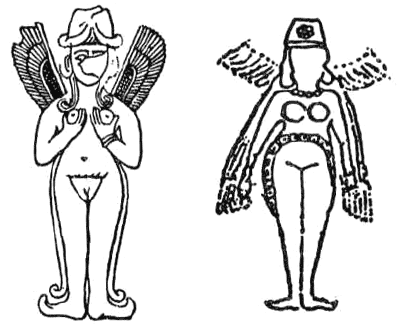
Figure 54
Between those bittersweet anniversaries,
Ishtar spent her time
roaming Earth’s skies in her Skychamber (see Fig. 42) and thus as
often as not depictions snowed her as a winged Goddess. She was, as
mentioned, the city Goddess of Aratta in the Indus Valley, and paid
diere periodic flying visits.
It was on one of her flights to the distant domain that
Inanna/Ishtar had a sexual encounter in reverse: she was raped by a
mortal; and, in such a reversal of roles, the man who did it lived
to tell about it.
He is known from historical records as Sargon of Aggade, the founder
of a new dynasty that was installed in a new capital (usually called
Akkad). In his autobiography, a text in the Akkadian language known
by scholars as The Legend of Sargon, the king describes the
circumstances of his birth in terms that remind us of the story of
Moses:
"My mother was a high priestess; I knew not my father. My
mother, the high priestess who conceived me, in secret she bore me.
She set me in a basket of reeds, its lid sealed with bitumen. She
cast me into the river; it did not sink [with] me. The river bore me
up, it carried me to Akki the irrigator. Akki the irrigator lifted
me up when he drew water. Akki the irrigator as a son made me and
reared me. Akki, the irrigator, appointed me as his gardener."
Then, as he was tending the garden, Sargon could not believe his
eyes:
One day the queen,
After crossing heaven, crossing earth,
Inanna -
After crossing Elam and Shubur,
After crossing . . .
The hierodule approached weary, fell asleep.
I saw her from the edge of my garden;
I kissed her and copulated with her.
Inanna, instead of being angry, found Sargon to be a man to her
liking. Sumer, its civilization a millennium and a half old by then,
needed a strong hand at the helm of its Kingship - a Kingship that,
after the glorious one in Uruk, kept changing capitals; the changes
led to conflicts among the cities and eventually between their
patron-Gods.
Seeing in Sargon a man of action and resolve, Inanna
recommended him as the next king over all of "Sumer and Akkad." He
also became her constant lover. As Sargon stated in another text
known as the Sargon Chronicle, "When I was a gardener, Ishtar
granted me her love, and for four and fifty years I exercised
Kingship."
It was in the reign of the successors of Sargon as kings of Sumer
and Akkad that Inanna/Ishtar incorporated the conjugations with the
king into the ceremonies of the New Year Festival, formalizing them
into the rite of the Sacred Marriage.
In earlier times it was the Gods who gathered to relive and retell,
on the occasion of the New Year, the epic of Creation and
the
odyssey of the Anunnaki in coming to and staying on Earth;
the
festival was called A.KI.TI - "On Earth build Life." After Kingship
was introduced, and after Inanna began to invite the king to her
Gigunu, a reenactment of the death of her sex partner - and then his
replacement by the king - was incorporated into the festival’s
proceedings.
The essence of the procedure was to find a way to have
the king spend the night with the Goddess without ending up dead ...
On the outcome depended not only the king’s personal fate, but
also the fate of the land and its people - prosperity and abundance
or the lack of them in the coming year.
For the first four days of the festival, the Gods alone participated
in the reenactments. On the fifth day the king came on the scene,
leading the elders and other dignitaries in a procession through a
special Way of Ishtar (in Babylon the processional way assumed
monumental proportions and architectural grandeur that inspire awe
to this day; it has been reconstructed in the Vorderasiatisches
Museum in Berlin).
Arriving at the main temple, the king was met by
the High Priest, who took away the king’s insignia and placed them
before the deity in the Holy of Holies. Then, returning to the
dethroned king, the High Priest struck him in the face and made him
kneel down for a ceremony of Atonement in which the king had to
recite a list of sins and seek divine forgiveness. Priests then led
the king out of town to a pit of symbolic death; the king stayed
there imprisoned while above the Gods debated his Destiny.
On the
ninth day he reemerged, was given back his insignia and royal robes,
and led back the procession to the city. There, at evetime, washed
and scented, he was led to the Gipar in the sacred precinct.
At the entrance to the Gigunu he was met by Inanna’s personal
attendant, who made the following appeal to the Goddess in behalf of
the king:
The sun has gone to sleep,
the day has passed.
As in bed you gaze upon him,
as you caress him -
give Life unto the king ...
May the king whom you have called to heart
enjoy long days at your holy lap . . .
Give him a reign favorable and glorious,
Grant his throne an enduring foundation . . .
May the farmer make the fields productive,
May the shepherd multiply the sheepfolds . . .
In the palace let there be long life.
The king was then left alone with the Goddess in the Gigunu for the
conjugal encounter. It lasted the whole night. In
the morning the king emerged, for all to see that he had survived
the night. The Sacred Marriage had taken place; the king could reign
on for another year; the land and people were granted prosperity.
"The Sacred Marriage Rite was celebrated joyously and rapturously
all over the ancient Near East for some two thousand years," the
great Sumerologist Samuel N. Kramer wrote in The Sacred Marriage
Rite.
Indeed, long after the days of Dumuzi and Gilgamesh, Sumerian
kings described poetically the ecstasy of such memorable nights with
Ishtar.
The biblical Song of Songs described the pleasures of love
in the Ta’an-nugim and several of the Prophets foresaw the demise of
the "House of Annugirri" (House of Pleasures) of the "Daughter of
Babylon" (Ishtar); and it is apparent to us that the Hebrew term
stemmed from the Sumerian Gigunu, indicating familiarity with the
Chamber of Pleasures and the rite of the Sacred Marriage well into
the middle of the first millennium B.C.
In the olden days the Gipar was the separate structure to which the
God and his official spouse retired for the night. The Gods who
stayed monogamous - Enlil, Ninurta - have kept it that way. Ishtar, in
her city Uruk, met her betrothed Dumuzi there but turned the inner
chamber, the Gigunu, to a place of one-night stands. The changes
introduced by Ishtar - the use of the Gipar for a new form of Divine
Encounter - gave ideas to some of the male deities of that time.
Some of the best-preserved records in this regard concern Nannar/Sin
(the father of Inanna/Ishtar) and the Gipar in his sacred precinct
in Ur. The role played by the male king in Ishtar’s rites was played
by an Entu, a "God’s Lady," (NIN.-DINGIR in Sumerian).
Excavations
there unearthed the quarters of the Entu in the southeastern part
of the sacred precinct, not too far from me ziggurat of Sin and
clearly away from the temple-abode of his spouse Ningal. Near the
Gigunu of the Entu the archaeologists found a cemetery where
generations of Entus were buried.
The cemetery, and the uncovered
structures, confirmed that the practice of having a "God ’s Lady"
besides the official spouse extended from the early Dynastic Period
well into Neo-Babylonian times - a span of time exceeding two
millennia.
Herodotus, the fifth century B.C. Greek historian and traveler,
described in his writings (History, Book I, 178-182) the sacred
precinct of Babylon and the temple-ziggurat of Marduk (whom he
called "Jupiter Bellus") - quite accurately, as modern archaeology has
shown.
According to his testimony,
On the topmost tower there is a spacious temple, and inside the
temple stands a couch of unusual size, richly adorned, with a golden
table by its side. There is no statue of any kind set up in the
place, nor is the chamber occupied of nights by any one but a
single native woman, who, as the Chaldeans, the priests of this God
affirm, is chosen for himself by the deity out of all the women of
the land.
They also declare - but I for my part do not credit it - that the God
comes down in person into this chamber, and sleeps upon the couch.
This is like the story told by the Egyptians of what takes place in
their city of Thebes, where a woman always passes the night in the
temple of the Theban Jupiter. In each case the woman is said to be
debarred all intercourse with men. It is also like the custom of
Patara, in Lycia, where the priestess who delivers the oracles,
during the time that she is so employed ... is shut up in the temple
every night.
Although the statements by Herodotus give the impression that any
maiden in the lands could have qualified for this widespread
practice, it was not really so.
One of the inscriptions found in the ruins of the Gipar at Ur was by
an Entu named Enannedu, who has been identified as the daughter of
Kudur-Mabuk, a king of the Sumerian city Larsa circa 1900 B.C. "I am
magnificently suited to be a Gipar-woman, the house which in a pure
place for the Entu is built," she wrote.
Interestingly, votive
objects found in the Ningal temple bore inscriptions identifying
them as gifts from Enannedu, suggesting to some scholars (e.g.
Penelope Weadock, The Giparu at Ur) that while serving as the human
consort of the God Nannar, the Entu also had to be on good terms
with the official spouse, "providing for the comfort and adornment
of the Goddess Ningal."
Other instances where kings sought the Entu office for their
daughters abound. The reason that emerges from the inscriptions is
that by having such intimate access to the God, the Entu could plead
the case and cause of the king for "long days of life and good
health" - the very requests made by the male king on the occasion of
the Sacred Marriage with Ishtar. With such a direct access to the
city God through the "God’s Lady," no wonder that successive kings
all over the ancient Near East built and rebuilt the Gipars in their
cities, making sure that their daughters, and no one else, would be
the Entu.
This high and unique office was totally different from
that of a variety of priestesses who served in the temples as "holy
prostitutes," referred to by the general term Qad-isktu - an
occupation frequently mentioned derogatively in the Bible (and
specifically prohibited for the Daughters of Israel: Deuteronomy
23:18). The Entu was different from the concubines that Gods (and
kings, or Patriarchs) had, in that the Entu did not and apparently
could not (through unknown procedures) bear children, while the
concubines could and did.
These rules and customs meant that kings seeking or claiming divine
parentage had to find other ways than descent from an Entu (who
could not bear children) or a concubine (whose offspring lost out to
those of the official spouse). It is thus no wonder that during the
last glorious era of Sumer, the time of the Third Dynasty of Ur,
some of its kings, emulating Gilgamesh, claimed that they were
mothered by the Goddess Ninsun.
The Assyrian king Sennacherib,
unable to make such a claim, asserted instead in one of his
inscriptions that,
"the Mistress of the Gods, the Goddess of
procreation, looked upon me with favor (while I was still) in the
womb of the mother who bore me and watched over my conception; Ea
provided a spacious womb, and granted me keen understanding, the
equal of the master Adapa."
In other instances Mesopotamian kings
asserted that this or that Goddess raised them or breastfed them.
In Egypt, too, claims of divine births were made (and depicted on temple walls - Fig. 55) by various kings and queens,
especially during the eighteenth dynasty (1567-1320 B.C.).
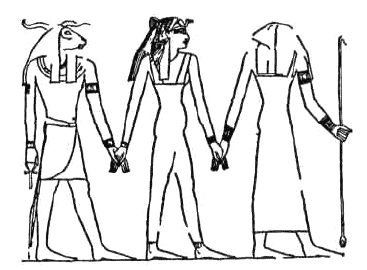
Figure 55
The
mother of the first Pharaoh of this dynasty was given the title
(probably posthumously) "Spouse of the God Amon-Ra," and the title
passed from mother to daughter in succession. When the Pharaoh
Thothmes I (also spelled Thothmose, Thutmosis) died, he left behind
a daughter (Hatshepsut) mothered by his legitimate wife and a son
born by a concubine.
In order to legitimize his reign after their
father died, the son (known as Thothmes II) married his half sister
Hatshepsut; but when he died after a short reign, the only son he
had was a young boy mothered by a harem girl; Hatshepsut herself
bore one or two daughters, but had no son.
(In our opinion Hatshepsut, when still a princess bearing the title
The Pharaoh’s
Daughter, was the biblical Pharaoh’s Daughter who raised the Hebrew
boy, calling him "Mose" after the divine prefix of her dynasty,
eventually adopting him as her son; but that is another subject).
At first Hatshepsut held the reins as a coregent with her half
brother (who some twenty-two years later became the Pharaoh
Thothmes/Tuthmose III). But then she decided that the Kingship was
rightfully only hers, and had herself crowned as a Pharaoh
(accordingly, her depictions on temple walls showed her with an
attached false beard . . .).
To legitimize her coronation and ascension to the throne of Osiris,
Hatshepsut had the following statement put into the Egyptian royal
records regarding her mother’s conception of her:
The God Anton took the form of his majesty the
king, of this [queen’s] husband the king. Then he
went to her immediately; then he had intercourse
with her.
These are the words which the God Amon, Lord of the
Thrones of the Two Lands, spoke thereafter in her
presence:
"Hatshepsut-by-Amon-created shall be the name of this
my daughter whom I have planted in thy body . . . She
is to exercise the beneficent kingship in this entire
land."
One of ancient Egypt’s most imposing royal temples is that of queen
Hatshepsut in Deir-el-Bahari, a section of Thebes on the western
side of the Nile (Fig. 56).
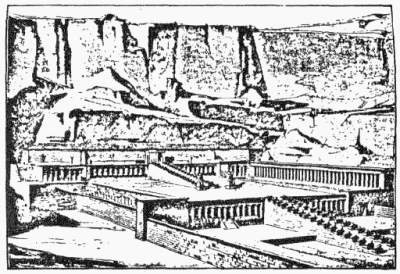
Figure 56
A series of ramps and terraces took
yesteryear’s worshiper (and today’s visitor) up to the level of
magnificent colonnades where (on the left) the queen’s expedition to
Punt was depicted in reliefs and murals, and (on the right) her
divine birth. In this section the painted reliefs show the God Amun
being led by the God Thoth to queen Ahmose, the mother of
Hatshepsut.
The accompanying inscription can well be considered one
of the most poetic and tender records of a sexual Divine Encounter,
as the God -
disguised as the queen’s husband -
entered the inner sanctum of the
queen’s nighttime chamber:
Then came the glorious God, Amun himself,
Lord of the thrones of the
Two Lands,
When he had taken the form of her husband.
They found her sleeping in the beautiful sanctuary;
She awoke at the
perfume of the God,
merrily laughed in the face of his majesty.
Enflamed with love, he hastened toward her;
She could behold him, in
the shape of a God,
When he had come nearer to her.
She exulted at the sight of his beauty;
His love entered into all her limbs.
The place was filled with the God’s sweet perfume.
The majestic God did to her all that he wished.
She gladdened him
with all of herself;
She kissed him.
To further strengthen her claim to divinely ordained Kingship,
Hatshepsut asserted that she was nursed by the Goddess Hathor,
mistress of the southern Sinai where the turquoise mines were and
whose Egyptian name, Hat-Hor ("House/ Abode of Horus"), signified
her role in raising and protecting the young God after his father
Osiris was slain by Seth.
Hathor, whose nickname was The Cow, was
depicted with cow’s horns or alternatively as a cow; and the
decorations in Hatshepsut’s temple showed the queen being nursed by
the Goddess-cow, suckling on her udder (Fig. 57).
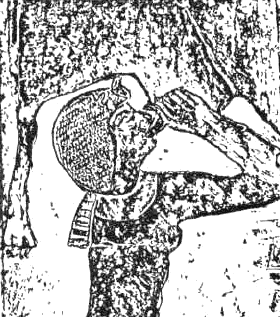
Figure 57
In the absence of a claim to semidivinity, the son and successor of
Thothmes HI, called Amenophis II, also asserted that he was suckled
by Hathor, and ordered that he so be depicted on temple walls (Fig.
58).
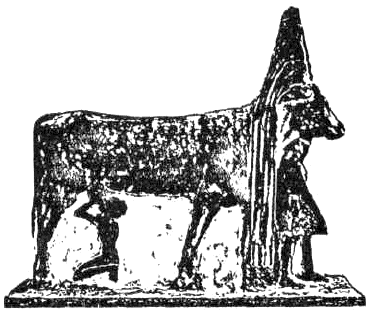
Figure 58
But a later successor, Ramses II (1304-1237 B.C.) asserted
again that his was a divine birth by recording the following secret
revelation by the God Ptah to the Pharaoh:
I am thy father . . .
I assumed my form as a ram. Lord of Mendes,
and begot thee inside thy august mother.
And a thousand years later, as we have mentioned, Alexander the
Great heard the rumors of his semidivine ancestry, conceived when
his mother had a Divine Encounter in her bedchamber with the God
Amon.
|
When Gods Grew Old
The Immortality of the Gods that Earthlings sought to attain was, in
reality, only an apparent longevity due to the different life
cycles on the two planets. By the time Nibiru completed one orbit
around the Sun, someone born there was just one year old. An
Earthling born at the same moment would have been, however. 3,600
years old by the end of one Nibiruan year, for Earth would have
orbited the Sun 3,600 times by then.
How did coming and staying on Earth affect the Anunnaki? Did they
succumb to Earth’s shorter orbital time, and thus to Earth’s shorter
life cycles?
A case in point is what had happened to Ninmah. When she arrived on
Earth as the Chief Medical Officer, she was young and attractive
(see Fig. 19); so attractive that when
Enki - no novice in sex
matters - saw her in the marshlands, "his phallus watered the dykes."
She was depicted still youthful and with long hair when (as Ninti,
"Lady Life") she helped create The Adam (Fig. 3).
When Earth was
divided, she was assigned the neutral region in the Sinai peninsula
(and was called Ninharsag, "Lady of the Mountainpeaks"). But when
Inanna rose to prominence and was made patron-Goddess of the Indus
Civilization, she also took the place of Ninmah in the pantheon of
twelve. By then the younger Anunnaki, who referred to Ninmah as
Mammi, "Old Mother," called her "The Cow" behind her back. Sumerian
artists depicted her as an aging Goddess, with cow’s horns ("A"
image below).
The Egyptians called the Mistress of the Sinai Hathor, and always
depicted her with cow’s horns ("B" image below).
As the younger Gods broke taboos and reshaped Divine Encounters, the
Olden Gods appear more aloof, less involved, stepping into the
breach only when events were getting out of hand.
The Gods, indeed,
did grow old. |
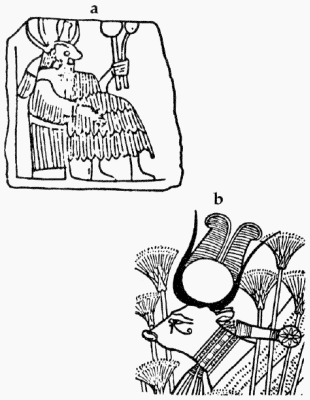
Back to Contents
|








